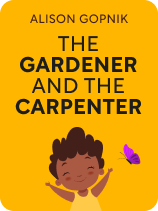

This article is an excerpt from the Shortform book guide to "The Gardener and the Carpenter" by Alison Gopnik. Shortform has the world's best summaries and analyses of books you should be reading.
Like this article? Sign up for a free trial here.
How do children learn through play? How can reading fiction boost your child’s development?
Children are constantly learning by watching and listening, but they also learn by playing—especially pretending. Similarly, reading fictional stories helps them learn empathy.
Continue reading to learn about the benefits of play in children.
Play: A Natural Learning Mechanism
How do children learn through play? First, let’s explain what we mean by “play.” According to The Gardener and the Carpenter by Alison Gopnik, biologists define play as having the following five characteristics: 1) Play is not work, 2) Play is fun, 3) Play is voluntary, 4) Play requires a safe and secure environment, and 5) Play relies on a pattern that includes repetition and variation. Because it’s child-directed, play is one of the most important ways that children guide their own development, which means it’s incompatible with carpenter parenting—if you try to force a child to play, direct how they play, or control the outcome of their play, it’s no longer play by definition. We should create environments that allow children to play, thereby supporting their natural growth.
| Not All Play Is Identical Play doesn’t look the same for all children. For example, autistic children often engage in parallel play—or playing near other children without playing with them—which can seem solitary and asocial. However, autistic children often socialize differently than non-autistic children, and parallel play between autistic children can be much more social than it appears from a neurotypical perspective. Autistic children also tend to engage in seemingly meaningless activities like lining up toys or opening and closing a door. Parents may feel the urge to alter the way autistic children play so it’s more “appropriate,” but deliberately changing the way a child plays means it no longer fits the definition of “play.” Instead, parents should encourage and participate in their children’s unique modes of play. |
While many animal species play in different ways, such as playing with objects or play-fighting with each other, human children may be the only species that plays by pretending. Children begin pretending as early as the age of one. Contrary to what many believe, children don’t have trouble distinguishing between fact and fiction—they know what they’re pretending isn’t real. They do it to learn and have fun.
So, how do children learn through play in this way? Gopnik suggests that pretending is a way for children to practice hypothetical or counterfactual thinking, which is the ability to imagine possibilities beyond what is currently real. This is the skill that allows us to change both our thinking and the world itself because it lets us realize that our current knowledge or way of thinking could be wrong and imagine how things could be different.
| How Important Is Pretend Play Really? Some experts contend that pretend play isn’t as important to children’s development as once thought, and they note methodological issues in studies about pretend play—for example, does pretend play really make a child more creative, or are creative children more likely to pretend in the first place? Others suggest that pretend play denies children the opportunity to gain real-world experiences, and they’ve conducted studies that suggest children over age three prefer doing things for real over playing pretend. This, as well as the belief that young children process and relate more easily to concrete rather than abstract things, underlies the Montessori approach to child-rearing, which encourages imagination as a creative connection to reality rather than as an end in itself—this approach fosters the practice of counterfactual thinking Gopnik discusses. |
Reading fiction can also assist in counterfactual thinking and has some of the same benefits as pretending. Both activities allow children to take on the perspectives of others, and the benefits of reading don’t end in childhood. Adults who read a lot of fiction—particularly literary fiction—are more empathetic and have a better understanding of others’ perspectives than people who don’t read as much fiction.
(Shortform note: Research suggests that reading fiction can actually change your entire personality. Reading literature puts you in a state of greater openness to personality change, and it appears to enhance traits such as empathy and altruism. The type of fiction you read may affect its impact on you as well: It seems that romance novels are the genre most likely to increase your empathy (with science fiction being the least likely).)

———End of Preview———
Like what you just read? Read the rest of the world's best book summary and analysis of Alison Gopnik's "The Gardener and the Carpenter" at Shortform.
Here's what you'll find in our full The Gardener and the Carpenter summary:
- The difference between gardner and carpenter parenting styles
- Why parenting should not be a form of work but an act of love
- How the schooling model fails to effectively support children’s learning






